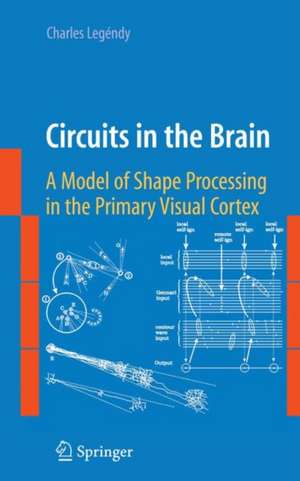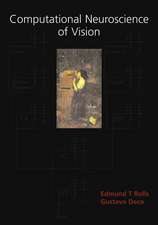Circuits in the Brain: A Model of Shape Processing in the Primary Visual Cortex
Autor Charles Legéndyen Limba Engleză Hardback – 13 apr 2009
Circuits in the Brain, with its “relational firing” model of shape processing, includes a step-by-step development of a set of multi-neuronal networks for transmitting visual relations, using a strategy believed to be equally applicable to many aspects of brain function other than vision. The book contains a number of testable predictions at the neuronal level, some believed to be accessible to the techniques which have recently become available.
With its novel approach and concrete references to anatomy and physiology, the monograph promises to open up entirely new avenues of brain research, and will be particularly useful to graduate students, academics, and researchers studying neuroscience and neurobiology. In addition, since Dr. Legéndy’s book succeeds in achieving a clean logical presentation without mathematics, and uses a bare minimum of technical terminology, it may also be enjoyed by non-scientists intrigued by the intellectual challenge of the elegant devices applied inside our brain. The book is uniquely self-contained; with more than 120 annotated illustrations it goes into full detail in describing all functional and theoretical concepts on which it builds.
| Toate formatele și edițiile | Preț | Express |
|---|---|---|
| Paperback (1) | 942.44 lei 6-8 săpt. | |
| Springer – 28 oct 2010 | 942.44 lei 6-8 săpt. | |
| Hardback (1) | 948.61 lei 6-8 săpt. | |
| Springer – 13 apr 2009 | 948.61 lei 6-8 săpt. |
Preț: 948.61 lei
Preț vechi: 1156.84 lei
-18% Nou
Puncte Express: 1423
Preț estimativ în valută:
181.54€ • 197.12$ • 152.49£
181.54€ • 197.12$ • 152.49£
Carte tipărită la comandă
Livrare economică 22 aprilie-06 mai
Preluare comenzi: 021 569.72.76
Specificații
ISBN-13: 9780387888484
ISBN-10: 0387888489
Pagini: 226
Ilustrații: XXVI, 226 p. 100 illus.
Dimensiuni: 155 x 235 x 16 mm
Greutate: 0.54 kg
Ediția:2009
Editura: Springer
Colecția Springer
Locul publicării:New York, NY, United States
ISBN-10: 0387888489
Pagini: 226
Ilustrații: XXVI, 226 p. 100 illus.
Dimensiuni: 155 x 235 x 16 mm
Greutate: 0.54 kg
Ediția:2009
Editura: Springer
Colecția Springer
Locul publicării:New York, NY, United States
Public țintă
ResearchDescriere
Dr. Charles Legéndy's Circuits in the Brain: A Model of Shape Processing in the Primary Visual Cortex is published at a time marked by unprecedented advances in experimental brain research which are, however, not matched by similar advances in theoretical insight. For this reason, the timing is ideal for the appearance of Dr. Legéndy's book, which undertakes to derive certain global features of the brain directly from the neurons.
Circuits in the Brain, with its "relational firing" model of shape processing, includes a step-by-step development of a set of multi-neuronal networks for transmitting visual relations, using a strategy believed to be equally applicable to many aspects of brain function other than vision. The book contains a number of testable predictions at the neuronal level, some believed to be accessible to the techniques which have recently become available.
With its novel approach and concrete references to anatomy and physiology, the monograph promises to open up entirely new avenues of brain research, and will be particularly useful to graduate students, academics, and researchers studying neuroscience and neurobiology. In addition, since Dr. Legéndy's book succeeds in achieving a clean logical presentation without mathematics, and uses a bare minimum of technical terminology, it may also be enjoyed by non-scientists intrigued by the intellectual challenge of the elegant devices applied inside our brain. The book is uniquely self-contained; with more than 120 annotated illustrations it goes into full detail in describing all functional and theoretical concepts on which it builds.
About the Author:
Dr. Charles Legéndy holds a bachelors' degree in electrical engineering from Princeton and a PhD in physics from Cornell. He wrote his first papers in solid-state physics (helicons), then turned his attention to the theory of data processing in the brain, the subject of the present book. Over the years, in addition, he was involved in a number of projects in experimental brain research (electrophysiology), aerospace engineering, and computers. Dr. Legéndy lives with his wife in New York City.
Circuits in the Brain, with its "relational firing" model of shape processing, includes a step-by-step development of a set of multi-neuronal networks for transmitting visual relations, using a strategy believed to be equally applicable to many aspects of brain function other than vision. The book contains a number of testable predictions at the neuronal level, some believed to be accessible to the techniques which have recently become available.
With its novel approach and concrete references to anatomy and physiology, the monograph promises to open up entirely new avenues of brain research, and will be particularly useful to graduate students, academics, and researchers studying neuroscience and neurobiology. In addition, since Dr. Legéndy's book succeeds in achieving a clean logical presentation without mathematics, and uses a bare minimum of technical terminology, it may also be enjoyed by non-scientists intrigued by the intellectual challenge of the elegant devices applied inside our brain. The book is uniquely self-contained; with more than 120 annotated illustrations it goes into full detail in describing all functional and theoretical concepts on which it builds.
About the Author:
Dr. Charles Legéndy holds a bachelors' degree in electrical engineering from Princeton and a PhD in physics from Cornell. He wrote his first papers in solid-state physics (helicons), then turned his attention to the theory of data processing in the brain, the subject of the present book. Over the years, in addition, he was involved in a number of projects in experimental brain research (electrophysiology), aerospace engineering, and computers. Dr. Legéndy lives with his wife in New York City.
Cuprins
Part 1. Concepts of Brain Theory 1. Lettvin’s challenge2. Issues concerning the nature of neuronal response3. 'Events' in the brain4. Cell assemblies5. Surprise, statistical inference, and conceptual notes6. A new term: ignitions which 'reach' or 'don’t reach' a neuron7. Confirmation loops, powered by self-ignitions8. Communicating 'relatedness' through time-linked ignitions9. Relational firing: broadcasting a shape through time-linked ignitions Part 2. Contour strings and the contour wave 10. Enter the contour string11. Drift of the retinal image12. Theory of the simple cell13. Theory of the complex cell14. Corner processing: theory of the hypercomplex cell Part 3. Nodes, links, bridgeheads 15. Nodes on contour strings16. Custom-made unstable networks made to support tracking17. Why is the drifting retinal image helpful in perception?18. The maintenance of moving nodes and bridgeheads Part 4. Firing games and the integration of contours 19. Making the first links by crawling along a contour string20. Using existing links to make new links on the same contour21. Completing a triangle of links
Textul de pe ultima copertă
Dr. Charles Legéndy's Circuits in the Brain: A Model of Shape Processing in the Primary Visual Cortex is published at a time marked by unprecedented advances in experimental brain research which are, however, not matched by similar advances in theoretical insight. For this reason, the timing is ideal for the appearance of Dr. Legéndy's book, which undertakes to derive certain global features of the brain directly from the neurons.
Circuits in the Brain, with its "relational firing" model of shape processing, includes a step-by-step development of a set of multi-neuronal networks for transmitting visual relations, using a strategy believed to be equally applicable to many aspects of brain function other than vision. The book contains a number of testable predictions at the neuronal level, some believed to be accessible to the techniques which have recently become available.
With its novel approach and concrete references to anatomy and physiology, the monograph promises to open up entirely new avenues of brain research, and will be particularly useful to graduate students, academics, and researchers studying neuroscience and neurobiology. In addition, since Dr. Legéndy's book succeeds in achieving a clean logical presentation without mathematics, and uses a bare minimum of technical terminology, it may also be enjoyed by non-scientists intrigued by the intellectual challenge of the elegant devices applied inside our brain. The book is uniquely self-contained; with more than 120 annotated illustrations it goes into full detail in describing all functional and theoretical concepts on which it builds.
About the Author:
Dr. Charles Legéndy holds a bachelors' degree in electrical engineering from Princeton and a PhD in physics from Cornell. He wrote his first papers in solid-state physics (helicons), then turned his attention to the theory of data processing in the brain, the subject of the present book. Over the years, in addition, he was involved in a number of projects in experimental brain research (electrophysiology), aerospace engineering, and computers. Dr. Legéndy lives with his wife in New York City.
Circuits in the Brain, with its "relational firing" model of shape processing, includes a step-by-step development of a set of multi-neuronal networks for transmitting visual relations, using a strategy believed to be equally applicable to many aspects of brain function other than vision. The book contains a number of testable predictions at the neuronal level, some believed to be accessible to the techniques which have recently become available.
With its novel approach and concrete references to anatomy and physiology, the monograph promises to open up entirely new avenues of brain research, and will be particularly useful to graduate students, academics, and researchers studying neuroscience and neurobiology. In addition, since Dr. Legéndy's book succeeds in achieving a clean logical presentation without mathematics, and uses a bare minimum of technical terminology, it may also be enjoyed by non-scientists intrigued by the intellectual challenge of the elegant devices applied inside our brain. The book is uniquely self-contained; with more than 120 annotated illustrations it goes into full detail in describing all functional and theoretical concepts on which it builds.
About the Author:
Dr. Charles Legéndy holds a bachelors' degree in electrical engineering from Princeton and a PhD in physics from Cornell. He wrote his first papers in solid-state physics (helicons), then turned his attention to the theory of data processing in the brain, the subject of the present book. Over the years, in addition, he was involved in a number of projects in experimental brain research (electrophysiology), aerospace engineering, and computers. Dr. Legéndy lives with his wife in New York City.
Caracteristici
Includes supplementary material: sn.pub/extras















